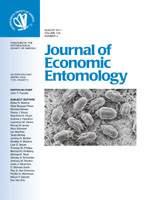This study examined whether economically important fruit fly species Anastrepha ludens (Loew), Anastrepha serpentina (Wiedemann), and Anastrepha obliqua (Macquart) (Diptera: Tephritidae) may opportunistically exploit guavas, Psidium guajava L. (Myrtaceae), growing near preferred natural hosts. We collected 3,459 kg of guavas and 895 kg of other known host species [sour orange, Citrus aurantium L.; grapefruit, Citrus paradisi Macfadyen; mango, Mangifera indica L.; white sapote, Casimiroa edulis La Llave and Lex.; sapote, Pouteria sapota (Jacq.); sapodilla, Manilkara zapota L.; and wild plum, Spondias purpurea L. and Spondias mombin L.] along an altitudinal gradient over a 4-yr period (2006–2009). Plants were growing in sympatry in 23 localities where the guavas are usually infested in the state of Veracruz, México. The guava samples yielded 20,341 Anastrepha spp. pupae in total (overall mean, 5.88 pupae per kg of fruit). Confirming previous reports, Anastrepha fraterculus (Wiedemann) and Anastrepha striata (Schiner) were found heavily infesting guavas in Veracruz. Importantly, although we did not find evidence that A. ludens and A. serpentina are able to attack this valuable commodity, we document for the first time in the agriculturally important state of Veracruz that P. guajava is an alternative natural host plant of A. obliqua. We recovered two fruit in the mango-growing locality of la Víbora, Tlalixcoyan, that harbored larvae of A. striata and A. obliqua. This finding has important practical implications for management of A. obliqua. Over the entire altitudinal gradient, when individual fruit infestation was examined, a dynamic pattern of species dominance was unveiled with guavas growing below 800 m above sea level mainly attacked by A. striata and a progressive replacement with increasing altitude by A. fraterculus. Interestingly, most individual fruit examined (97%) harbored a single species of fruit fly, a finding that may be taken as evidence of competitive displacement among sympatric species of fruit flies. Based on this study and previously published work by us on this topic, we conclude that literature reports indicating that A. ludens and A. serpentina infest guavas under field conditions should be questioned.
How to translate text using browser tools
1 August 2011
Anastrepha ludens and Anastrepha serpentina (Diptera: Tephritidae) do not Infest Psidium guajava (Myrtaceae), but Anastrepha obliqua Occasionally Shares this Resource with Anastrepha striata in Nature
Andrea Birke,
Martín Aluja
ACCESS THE FULL ARTICLE
It is not available for individual sale.
This article is only available to subscribers.
It is not available for individual sale.
It is not available for individual sale.

Journal of Economic Entomology
Vol. 104 • No. 4
August 2011
Vol. 104 • No. 4
August 2011
Anastrepha
competitive displacement
host status
infestation patterns
Psidium guajava




